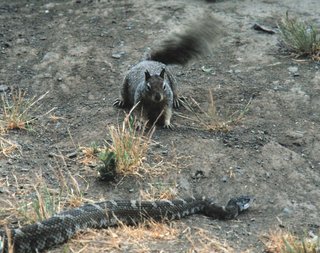tags: researchblogging.org, evolution, squirrels, rattlesnakes, tail-flagging, behavior, biology
A mother squirrel rapidly waves her tail to warn off a rattlesnake in a confrontation staged by researchers in May 1987. Adult squirrels are immune to rattlesnake venom, but their offspring are vulnerable. New infrared research found that heat from the mother's tail sends an alarming signal to the slithery predators.
Image: Donald H. Owings, UC Davis.
Researchers have long been mystified by the defensive behaviors exhibited by California ground squirrels, Spermophilus beecheyi, when they are confronted by venomous rattlesnakes. The furry animals not only kick pebbles and dirt at the hungry snakes, but they also erect their tail, fluff out its hairs and wave it vigorously side-to-side, even at night when snakes are unable to see. This defensive behavior, known as tail flagging, is very different from defensive behaviors exhibited by the squirrels towards predatory birds and mammals, or even towards gopher snakes. Why do squirrels use this specific behavior for rattlesnakes only?
Squirrels and snakes have coexisted for more than one million years, matching one another in their evolutionary struggle for survival. For example, rattlesnakes evolved a poisonous venom, so the squirrels evolved immunity to rattlesnake venom. Because they are immune to the venom, the squirrels will bite the snakes with their sharp teeth when confronted by them, so they are rarely preyed upon by rattlesnakes.
Rattlesnakes have a "pit organ", a special organ that is lined with tens of thousands of thermoreceptors, and is used to detect and locate warm prey, especially at night when ambient temperatures are cooler than during the daytime. Additionally, these organs are sensitive to very small temperature changes.
So why do squirrels use tail flagging to warn the snakes away from a particular area, even in the dark when the snakes cannot see this behavior? Adult squirrels, particularly the females, use these behaviors to protect their pups, which are vulnerable to the snakes' venom and are a favorite delicacy for rattlesnakes, consisting of approximately two-thirds of their diet throughout the spring and summer. So based on this evidence, it was hypothesized that the squirrels were giving a thermal signal to warn the snakes away from the entrances to burrows.
Using that information, a group of scientists at UC Davis, headed by behavioral biologist, Aaron Rundus, staged confrontations between rattlesnakes and squirrels, and used infrared cameras to record body temperature changes in the squirrels while they engaged in their defensive tail flagging behavior. (below; 0:16).
The team found that the temperature in the squirrels' tails increased by as much as 12 degrees when they flagged their tails at rattlesnakes. Thus, waving their extra-warm tail around allowed the squirrels to make their infrared image appear larger than they really were to the hungry snakes.
Rundus said that squirrels heat their tails by shunting warmed blood into them. This physiological change is probably triggered by rattlesnake smells or sounds.
The hotter tails were interesting, but communication is a two-way event. A message must be understood by the recipient, too. So the team studied rattlesnakes' reactions to tail flagging. To do this, Rundus and UC Davis engineering professor Sanjay Joshi, a robotics specialist, designed a robo squirrel from a taxidermist's mount. This robosquirrel could wave its tail menacingly with or without extra heat.
The team found that as the robosquirrel's tail grew warmer, the rattlesnake's body posture changed from slithering to a coiled, rattling defensive position. This response was probably learned from previous interactions with other adult squirrels.
"It's a conspicuous signal that you've been detected and you're probably going to be harassed," said Rundus of tail flagging, "and potentially harmed if you stay in this area."
But interestingly, this hot tail flagging signal is only used for rattlesnakes. When a squirrel was confronted by a nonvenomous gopher snake, which lacks pit organs and is therefore insensitive to infrared radiation, the squirrel kicked pebbles and dirt at the snakes and tail flagged, but their tail remained cool (below; 0:15).
"I was definitely surprised that we got a difference between gopher snakes and rattlesnakes," said Rundus.
The researchers said that squirrels may distinguish infrared-sensitive rattlesnakes from gopher snakes and other predators based on rattlers' distinct odor and sound.
"The result marks the first discovery of one animal communicating to another by infrared," said Rundus.
This is, in my opinion, one of many examples of the exquisite specificity of evolution.
The paper was published last week in the Proceedings of the National Academy of Sciences, and earned Rundus an award for best student paper from the Animal Behavior Society.
Sources
"Ground squirrels use an infrared signal to deter rattlesnake predation" by Aaron S. Rundus, Donald H. Owings, Sanjay S. Joshi, Erin Chinn, and Nicolas Giannini (2007). Proceedings of the National Academy of Sciences [free PDF]
NPR (streaming interview)
Sacramento Bee (quotes).


Normally, in any standoff between mammal and reptile not involving myself or immediate family, I root for the exotherm, but I can't deny that this is a pretty awesome adaptation.
Well played, ground squirrel. Well played.
The paper also points out that squirrels are more likely to tail-flag in the dark, which is when rattlers are most likely to hunt. Obviously, in those conditions, the visual aspect of the signal is irrelevant, but the heated tail will stand out even more against the cool night air.
Very cool. It occurs to me that insects and most reptiles seems to wear their predator-repellent signals ("Don't even THINK of eating me") as permanent full-body displays, whereas mammals tend to pull out a behavioral signal for the occasion. Something like a rattler's warning would fit in between those....
Great article!!